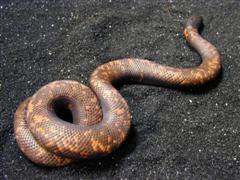Python - Calabar Burrowing
Calabar Sand Boa Scientific Name: Calabaria reinhardtii
Thu, 17th April, 2025 - 10:09 am GMT
Sponsor Ads:

Alternative Name
Calabar Sand Boa Scientific Name: Calabaria reinhardtiiBasic Info
The Calabar Burrowing Python is small, averaging around three feet as a mature adult. The body is cylindrical and the head and tail are both blunt. They have small eyes and smooth scales. The Calabar Burrowing Python's body is usually an auburn color, with markings of orange, beige or yellow. The head and tail are both brown, sometimes with bands of white. The blunt tail, along with the white bands when present, make the tail and head very hard to tell apart. The average mature Calabar Burrowing Python reaches somewhere between 2 and 2.5 feet in length. It is rare that they will exceed 3 feet in length.
Health
The "cool" area of the enclosure should be kept at between 75 and 80 degrees Fahrenheit with a warmer area about 85 degrees. This is a very shy species of snake. Provide plenty of hiding spaces, and keep the snake in a low-traffic area of the house, if possible. Breeding The Calabar Burrowing Python is very difficult to breed in captivity. It is possible to breed them in captivity, if they are given plenty of food and water, many places to hide, and are generally left alone. When the female is gravid, she should be separated into a laying box with a damp substrate. They lay very small clutches of between one and three eggs. When born, the hatchlings are very large.Habitat
They are found in Africa and make their home in rocky forests or areas with thick vegetation. They will also live in forests that have plenty of leaf cover.Behavior
The Calabar Burrowing Python is also known as the Calabria, the Calabar Python, the West African Burrowing Python, the Burrowing Python, and the West African Ground Python. While all of these names utilize the word "python," there is some debate as to whether this snake is actually a boid. They are small, non-aggressive snakes, especially for constrictors. Like many other animals that derive their name from their lifestyle, the Calabar Burrowing Python is a burrowing snake. While primarily terrestrial, the Calabar Burrowing Python has been known to climb into small bushes and on fallen logs. They are mostly nocturnal, although some members of the species have been observed foraging, hunting and even eating during the day. Daytime activity is most common between September and March. . They are adept at raiding mouse nests and are capable of constricting over four nestlings at once. When threatened, the snake is more likely to assume defensive posturing then attack. They usually roll themselves into balls when threatened, often with their head at the center of the ball. When first threatened, they press their chin onto the ground and wave their tail slightly. The tail resembles the head, confusing predators. The Calabar Burrowing Python is currently classified with boids and is considered one of the Erycine families. They are very difficult to classify because they share characteristics with other snakes and are significantly different from other Erycines in several ways. For example, they are oviparous, meaning they lay eggs, while most other Erycines give birth to live young. Their skulls are similar in structure, to both the Ball Python and the Rubber Boa. Many scientists place the Calabar Burrowing Python in the family calbaridae, in which it would be the only member. With this taxonomy, it would be one of the pseudoboa groups.Origin
West AfricaHistory
N/ACommon Foods
The Calabar Burrowing Python feeds primarily on mice and other small rodentsSponsor Ads:
Shallit's Razor: Never attribute to conspiracy what may be adequately explained by stupidity or incompetence.
Python - Calabar Burrowing
Coded by: BGID® | ALL RIGHTS RESERVED Copyright © 2000-2025
Disclaimer | Privacy | Report Errors / Contact | Credits


 President of the United States of America - Real Estate mogul, Pageant owner and now one of the most controversial men in political history.
President of the United States of America - Real Estate mogul, Pageant owner and now one of the most controversial men in political history.  Politician, US Vice President and President of the USA - Joseph Robinette Biden Jr.
Politician, US Vice President and President of the USA - Joseph Robinette Biden Jr.  versus
versus  Russia: 'The Evil Empire'? Are they all that bad or is it just the USA trying to portray Russia as bad because they are a world power with land bigger and a society very different from the USA ideal?
Russia: 'The Evil Empire'? Are they all that bad or is it just the USA trying to portray Russia as bad because they are a world power with land bigger and a society very different from the USA ideal?  Global warming has been in and out as the "latest" hot topic for many years. It is, according to modern scientists, the result of man-made industrial pollutants, clearing forested areas, agriculture, etc. But now they are thinking it started way before the Industrial Revolution...
Global warming has been in and out as the "latest" hot topic for many years. It is, according to modern scientists, the result of man-made industrial pollutants, clearing forested areas, agriculture, etc. But now they are thinking it started way before the Industrial Revolution... 
 Corona virus
Corona virus 
 Users with wide screen monitors can benefit from more content on every page.
Users with wide screen monitors can benefit from more content on every page.